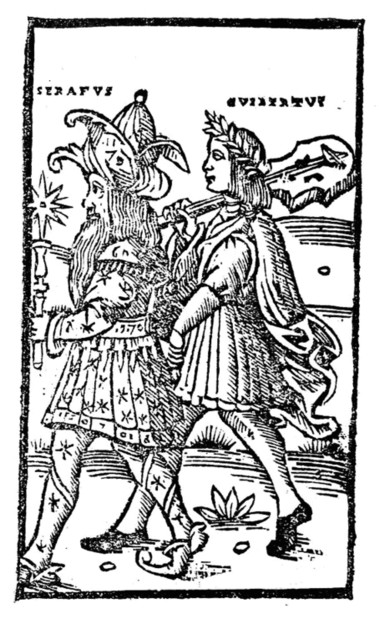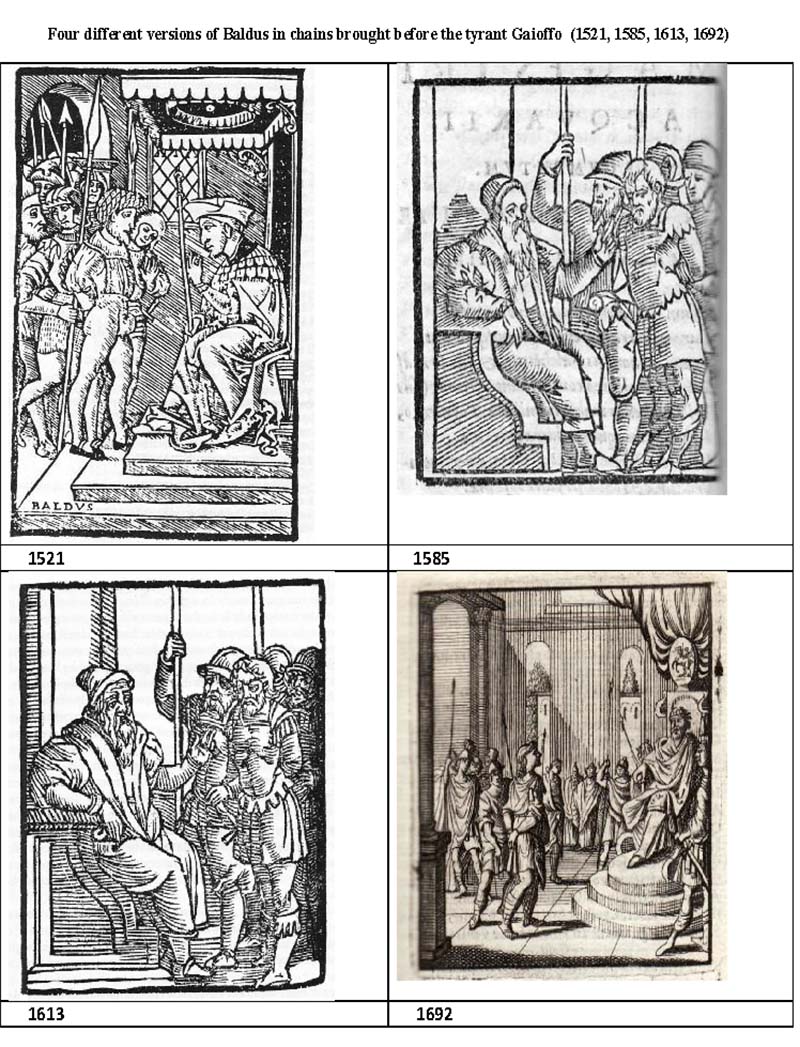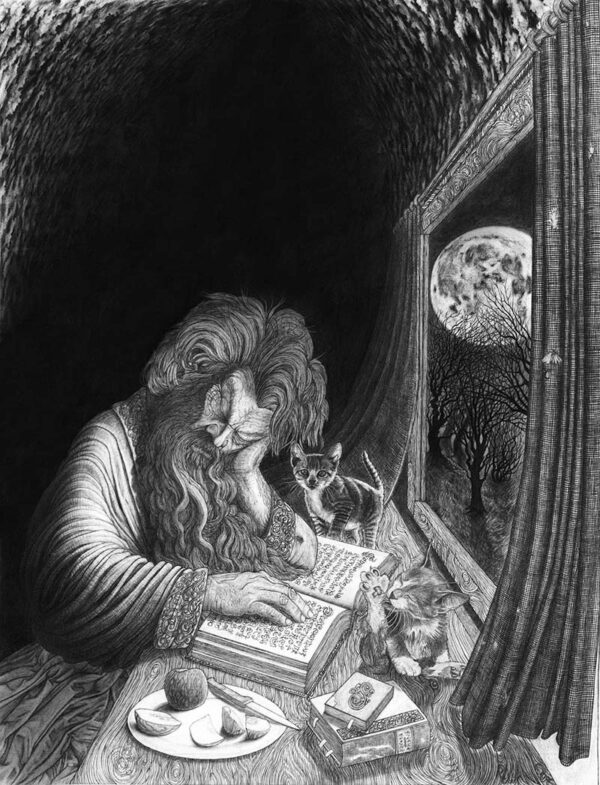Overview of Teofilo Folengo’s writings
For each text as a whole, and for their separate parts, the goal is to offer:
- Year of publication, Title, Publisher, Description of contents
- Original edition, digital reproduction or photocopy
- Transcription (with minimal alterations)
- Translations, commentaries, etc.
Additional online resource: The Folengo Project by Patrizia Sonia De Corso: https://www.bibliography.center/bibliography
New 2024: The Bibliothèque nationale de France offers a digitized copy of the Chaos del Triperuno, 1527, for non-commercial use only. For more, please see below at 1527.
https://www.academia.edu/115936556/Chaos_del_Triperuno_1527_BNF
1517
Title page:
MERLINI COCAI POETAE MANTUANI LIBER MACARONICES LIBRI XVII NON ANTE IMPRESSI.
(Seventeen Macaronic Books by Merlin Cocaio, Mantuan Poet, not previously published.)
Publisher (end page):
Venetiis in aedibus Alexandri Paganini. Inclito Lauredano Principe. Kalen. Ianua. M.D.XVII.
(Venice, Alessandro Paganini Press. With the Illustrious Doge, Loredan [ruling]. Jan. 1, 1517.)
Description:
The first edition of the Macaronic works of Teofilo Folengo (called Paganini (P) after the publisher) is a beautiful work printed in graceful Italic font, 27 lines per page, with explanatory and humorous glosses in the margins. The author is Merlinus Cocaius, pseudonym and pseudo-personality of Teofilo Folengo. A lively ten-page account of the discovery of the text and a presentation of the author is offered by one Aquario Lodola (likely another pseudonym). Two eclogues follow and then the main work: an epic poem entitled Baldus after the titular hero: 6,114 hexameters in 17 books with brief argomenti (contents) preceding each book. The volume is written in Macaronic Latin, an artful combination of Latin syntax and vocabulary combined with words from the literary Italian of the era and various Northern Italian dialects.
Digital copies:
https://play.google.com/books/reader?id=akpoAAAAcAAJ&pg=GBS.PP6 (downloadable)
https://openlibrary.org/books/OL26220262M/Merlini_Cocai_poetae_mantvani_Liber_macaronices_libri_.xvii._non_ante_impress (downloadable)
Open Library copy PDF Merlini Cocai Poetae Mantuani Liber Macaronices Libri XVII
Photocopy/ Anastatic editionMerlini Cocai Poetae Mantuani Liber Macaronices Libri XVII Non Ante Impressi, Venetiis in aedibus Alexandri Paganini inclito Lauredano principe Kale(ndis) Ianua(rii) MDXVII. Edited by Otello Fabris e Roberto Stringa, from the original text provided by Stringa, Grafiche Fantinato di Romano d’Ezzelino (VI), 2017.
Introductory letter: Discovery of the Text and Praise of Merlin by Aquario Lodola
PDF: Teofilo Folengo 1517 Aquario Lodola Original and English:
The 1517 Eclogues:
These texts are available in the critical edition by Massimo Zaggia, Macaronee minori Zanitonella, Moscheide, Epigrammi by Teofilo Folengo (Turin, Einaudi, 1987), texts with translations in Italian, detailed notes and a glossary.
1520 Reprints of the 1517 edition with some variations:
Macaronea. Merlini Cocai, poete mantuani, macaronices libri XVII, post omnes impressiones ubique locorum excussas, novissime recogniti omnibusque mendis expurgati…: Cesare Arrivabene, January, 1520
Agostino da Vimercate, Milan, Nov. 17, 1520
Digital photocopy of the Arrivabene edition from the French National Library: https://gallica.bnf.fr/ark:/12148/bpt6k71190q
Comparison and English translation of marginal glosses (often humorous) from the 1517 Paganini and the 1520 Arrivabene:
PDF: Baldus Glosses Compared 1517 1520 March 2011
1521
Title page and publisher:
OPUS MERLINI COCAII, Poetae Mantuani Macaronicorum totum in pristinam formam per me Magistrum Acquarium Lodolam optime redactum, in his infra notatis titulis divisum. Tusculani Apud Lacum Benacensem. Alexander Paganinus. M.D.XXI DIE V. IANUARII.
(The Macaronic Works by Merlin Cocaio, Mantuan Poet, all excellently restored to pristine condition by me, Magister Acquario Lodola, divided into the sections noted below, Toscolano, Lago di Garda, Alessandro Paganini [Press], January 5, 1521)
The greatly expanded second edition is known as the Toscolana (T), for the town in Northern Italy where Paganini had his press. Many more prefatory pieces appear (see list below), and the Baldus is now twice as long (12,668 hexameters). 51 woodcut prints illustrate the story nicely. Additionally, there are many more eclogues, a mock-epic between flies and ants, a list of errors corrected, a table of contents, a sonnet, and more. Each page is packed: there are 37 lines per page on a smaller area of print than the 27 lines per page of the 1517 edition. About 100 copies of this edition are still in existence today. Some of these feature a dialogue in Latin about the author and letters from him to the editor, and the editor to him.
Three of the digital image copies online:
MDZ. Munich: https://www.digitale-sammlungen.de/en/view/bsb10190234?page=1Library of Congress: https://lccn.loc.gov/51006170Google Play Books, full text with letters to and from the editor Paganini: https://play.google.com/store/books/details/Teofilo_Folengo_Opus_Merlini_Cocaii_Macaronicorum?id=HvM7AAAAcAAJ
Photocopy/ Anastatic edition: Opus Merlini Cocaii poetae Mantuani Macaronicorum, Tusculani Apud Lacum Benacensem, Alexander Paganinus, MDXXI, die V Ianuarii. Edited by A. Nuovo, G. Bernardi Perini, R. Signorini, Volta Mantovana, Mantova, Bassano del Grappa, Associazione Amici di Merlin Cocai, 1994
Even though Folengo would go on to produce two further revised editions, the 1521 version (called Toscolana) remained the most popular in the decades and centuries to follow. Over 100 copies are still available online, in libraries and in private collections. And it was reproduced and republished: 1522, 1564, 1572, 1573, 1581, 1585, 1613 (new woodcuts), 1692 (new engravings), etc.
Parts of volume available in DRAFT transcription: Toscolana Baldus, searchable text and marginal glosses, needs spelling and punctuation corrected.
Toscolana Baldus Aug 25 2011 Folengo 1521 Toscolana from Portioli Aug 2011
Other works in the Toscolana volume: The two original 1517 eclogues are expanded into a pastoral work titled Zanitonella, these and a Libellus Epistolarum et Epigrammaton are included: see Macaronee minori by Massimo Zaggia cited above.
T. Folengo, Il Baldo padano: Books 1-10 with a translation into Italian/ Paduan dialect by Giuseppe Tonna, edited by T. Tonna and G. Bernardi Perini, Mantua and Bassano del Grappa, Assoc. Amici di Merlin Cocai, 1998.

Folengo 1521 Woodcuts PDF: Folengo 1521 Woodcuts with Directory and thumbnails reduced
Folengo 1573 Woodcuts PDF: 1573 Folengo Woodcuts 7 09
Folengo 1585 Woodcuts PDF: 1585 Folengo Woodcuts 7 09
Folengo 1613 Woodcuts PDF: 1613 Folengo Woodcuts
Folengo 1692 Engravings PDF: 1692 Folengo Engravings 7 09
Four versions of illustrations: Baldus before Gaioffo

Scene from Baldus, Book 5, as the young hero faces the ruler of Mantua
Four versions of Baldus facing Gaioffo 2009
Modern edition: Le opere maccheroniche di Merlin Cocai, edit. by Attilio Portioli, Mantua, Mondovi, 1882, 2 vol.
This two volume edition of the Toscolana by A. Portioli is the basis of the PDF I made to aid in navigating the 1521 Baldus until a better online edition becomes available. It includes line numbers and the marginal glosses (as footnotes) with English translations. It should be checked against the original for spelling and punctuation.
PDF: Folengo 1521 Toscolana from Portioli Aug 2011
The 1521 Toscolana (T) edition features many exciting peripheral pieces. Below the original texts with my English translations, and also all bound together in one visually unappealing pdf: Folengo Peripheral pieces 1521
Contents:
1. Aquario Lodola to Scardaffo: 1521 Angry Letter to Scardaffo October 22 2012
A new angry letter from Aquario Lodola to a scoundrel named Scardaffus
2. Aquario Lodola in Praise of Merlin (1521): 1521 Aquario Praise of Merlin October 22 2012
A significantly altered version of the 1517 Prefatory letter by Aquario in Praise of Merlin
3. Merlin’s Apology: 1521 Apologetica Oct 22 2012
Explanation of the language and ethos of Macaronics
4. Macaronic Metrics: 1521 Normula macaronica Oct 22 2012
Normula macaronica de sillabis a few paragraphs explaining Macaronic Latin metrics
5. Macaronic Publishing 1521: Five Letters by Teofilo Folengo, Alessandro Paganini and Federico Gonzaga: 1521 Letters to and from the editor etc Nov 4 2012
A letter from Folengo’s pseudonym-personality, Merlin, to the printer Paganini, claiming that he does not want to relinquish his own copy for publication; a response from Paganini telling him that he got a copy of the text from Federico Gonzaga (accompanied by the letter Gonzaga sent to Paganini, 1520); a letter to the reader from Paganini, and a response from the author (Merlin). Original letters and English translations. These letters are found in a small percentage of the 100 or so known copies.
6. Revealing Dialogue: 1521 DIALOGUS PHILOMUSI Nov 4 2012
Dialogus Philomusi a dialogue in Latin which reveals information about the author as a young man, found only in a small fraction of extant editions.
1526
Orlandino, Venice, July, 1526, Gregorio de Gregori; 2nd edition, same year: Venice, Fratelli da Sabio, 1526.
8 books of Italian octaves, ostensibly tells the story of young Orlando (Roland in French chivalric epics), but is a polemical work, containing Lutheran ideas and many sexual allusions.
3rd edition: Orlandino qual tratta d’arme e d’amor per Limerno Pitocco da Mantua composto. Rimini, Girolamo Soncino, 1527.
Additional editions: 1530, 1539, 1550, 1560, etc.
1550 edition by Agostino Bindoni, Venice: https://play.google.com/books/reader?id=7k8FggjShVUC&pg=GBS.PP1&hl=en
1773 Orlandino with notes: https://play.google.com/store/books/details/Teofilo_Folengo_Opus_Merlini_Cocaii_Macaronicorum?id=HvM7AAAAcAAJ
Orlandino: Excellent critical edition, thoroughly annotated, by Mario Chiesa, Padova, Antenore, 1991.
Orlandino online from the critical edition by Mario Chiesa: http://www.liberliber.it /mediateca/libri/f/folengo/orlandino/pdf/orland_p.pdf
Un asinel poledro che vint’anni
stentato avea de frati in un convento.
Pensate quante pene, quanti danni
ivi sofferse l’animal scontento!
Al fin ruppe ‘l capestro e for d’affanni
calci e corregie trette piú di cento;
e, scampandone, fe’ da bon ladrone:
rubbò a gli frati la discrezione. (2.15)
Marginal gloss: La discrezion de l’asino ove fu tolta
APOLOGIA: An archly funny defense of his outspoken Orlandino, added to the second edtion of 1526: Apologia de l’autttore, Venice, Fratelli da Sabio,
Orlandino Apologia English-Italian
1527
Chaos del Triperuno, Venice, Fratelli da Sabio (and Nicolo Garanta), January 1, 1527.
The Chaos del Treiperuno offers a fabulous exploration of the interior self, in a variety of prose and poetry styles, in Italian, Latin and Macaronic Latin.
Good clean digital copy of the 1527 edition of Chaos del Triperuno: https://play.google.com/books/reader?id=bDBeAAAAcAAJ&pg=GBS.PP1&printsec=frontcover&output=reader
Photocopy edition of the 1527 reprint: from a copy owned by Roberto Stringa, through Amici di Merlin Cocai, (Bassano, Graffiche Fantinato, 2010).
Transcription of the original, based on the much altered text of U. Renda, and still in need of correction but with all the marginal glossesand with a Draft English translation: Chaos del Triperuno, with English April 18 2016 Total Chaos Apr 18 2016
Later editions: A good digital photocopy of the 1546 reissue of the Chaos: https://play.google.com/store/books/details/Teofilo_Folengo_Chaos_del_tri_per_uno?id=nyQ8AAAAcAAJ
Le opere maccheroniche di Merlin Cocaio edited by Attilio Portioli, Mantova: Mondovi, 1889, vol.3: http://books.google.com/books
Teofilo Folengo: Opere Italiane, edited by Umberto Renda, Scrittori d’Italia, Bari: Laterza, 1911, vol. 1: http://www.bibliotecaitaliana.it/exist/ScrittoriItalia/browse/autore-autore.xq?autore=Folengo,%20Teofilo
Alluring poem at the center of Chaos:
Alluring poem at the center of Chaos del Triperuno with English translation
CLIO Center of Chaos Nov 15 2021
Some aspects of the epic Baldus and the autobiographical Chaos compared:
Allegorical Reading article July 2011 Allegorical Reading July 2011
Lettura allegorica (above article translated into Italian) Lettura allegorica luglio 2011
1533
LA HUMANTIA’ DEL FIGLIUOLO DI DIO, In ottava rima, per Theophilo Folengo Mantoano. Venice, Aurelio Pincio, August 14, 1533.
(The Humanity of the Little Son of God, in octaves, by Teofilo Folengo, Mantuan)
Italian octaves, books, approximately 100 octaves per book. Poetic retelling of Bible stories, with some personal commentary — see for example a moving rendition of the Story of Susanna, Book 1.36-76; may be tinged with coded sexual concepts, as are his other (Latin) works published in 1533. Beautiful digital photocopy of the original Italian at Google Play Books.
Masterful critical edition by Simona Gatti Ravedati: La umanita’ del Figliuolo di Dio by Teofilo Folengo, edited and annotated by Simona Gatti Ravedati, Alessandria (Torino), Edizioni dell’Orso, 2000.
1533 (but thought to be 1534)
Dialogi quos Pomiliones vocat, Varium poema, Janus. In Promontorio Minervae ardente Sirio 1533 (Punta Campanella near Naples, July, 1533)
The volume contains two works in Latin by Teofilo Folengo and one by his brother Giambattista (Giovanni Battista) Folengo: Dialogi, quos Pomiliones vocat (Dialogues He Calls Little Pieces) by GB Folengo: 154 pages of prose, mostly in dialogue format; by Teofilo: Varium poema (DIverse Poems) 68 poems in Latin; and Janus, a 559 hexameter narrative.
A photocopy edition of the whole volume is available through the Associazione degli Amici di Merlin Cocai (Bassano del Grappa, Grafiche Fantinato, 2011).
The texts:
Transcription of the whole volume (99% correct): 1533 Pomiliones Varium Poema Janus Latin Oct 30 2014
Most faithful translation of the first part, English translation (draft) and annotations: 1533 Pomiliones Oct 12 2021
Varium poema with English August 23 2020
Commentaries:
Introduction to 1533 volume May 18 2015
Additional Notes and Illustrations to the Varium poema May 5 2014 Varium poema Additional Notes Draft May 5 2014
Preliminary Commentary on Folengo’s Janus: Janus Commentary Jan 24 2013
Commentario provvisorio sul Janus, translated by Gabriele Codifava and Ann Mullaney Commentario sul Janus di Folengo 9 ott 2012
c. 1535 (no date of publication given)
Macaronicorum Poema. Called Cipadense, the third version of the Macaronic works and the last published by the author.
Reissued in 1555 by Boselli
Two Prefatory pieces, one at the beginning of the volume, one at the end.
Francesco Folengo a gli lettori (Francesco Folengo to the readers) Francesco Folengo Cipadense April 9 2014
Nicolo Costanti to the readers: Nicolo Costanti Cipadense April 9 2014
A favorite quatrain from one of the “Epigrammata” at the end of the volume, “Ad Baldum de Ira”:
Quae semel vento ruit acta pinus
Haud reviviscit, nec Acer, nec Ilex,
Nescit heu certa, semel hinc quod exit,
Lege reverti.
(That Pinus has fallen, once downed by the wind, it can hardly revive, nor [can] the Maple, or Holm Oak. Once it has gone from here, alas, it’s unable, by firm law, to go back.)
Works published posthumously:
1552
Merlini Cocalii Poetae Mantuani Macaronicorum Poemata
Known as V, for Vigaso Cocaio: peripheral text:
Vigaso Cocaio to the readers Italian and English 1552 Vigaso Cocaio Italian and English
Baldus translated into Italian and annotated by Mario Chiesa, Turin: UTET 1997
Baldo translated into English by Ann Mullaney, text by Mario Chiesa, I Tatti, (Harvard U Press) 2007, 2010.
Earlier Italian versions:
Giuseppe Tonna translation, text edited by G. Dossena) Il Baldo (Milano, Feltrinelli, 1958). Emilio Faccioli, Baldus, (Torino, Einaudi, 1989).
1539 La Palermitana (posthumous, first published in 1876).
Teofilo Folengo: La Palermitana, critical edition by Patrizia Sonia De Corso, Florence, Olschki, 2006.
48 canti in terza rima: idiosyncratic retelling of biblical stories from the Old and New Testaments; Folengo (the author) assists Joseph by holding Baby Jesus during his circumcision, (Palermitana, Bk 2, canto 3).
c. 1540 Hagiomachia. (Battles of the Saints.) First published (in part) by Antonio Rafanelli, 1898-1902, Salerno, Fruscione e Negri.
Hagiomachia di Teofilo Folengo, edit. Antonio Rafanelli in Perseus Collection: Humanist and Renaissance Italian Poetry in Latin http://www.perseus.tufts.edu Perseus
T Folengo Hagiomachia Contents
TOOLS:
Useful publication for comparing the four editions of the Baldus: Enrico Gragnani, “Le quattro redazioni del Baldus 1517-1552,” thesis, University of Rome, 2003
Ways of looking at certain aspects of Folengo’s work: Hoe of Hoes August 24 2020
Drawing, Eternal Merlin/ Old Man Reading by Rowan Pope, 2009

Rowan Pope Drawing Merlin or Old Man Reading